The Enrollment Rescue Dilemma: How Sponsors and Sites Can Make the Most of a Tough Situation
Survey uncovers key best practices that sponsors, CROs, and sites should consider when faced with patient enrollment challenges.

Studies in “enrollment rescue mode” present dilemmas for sponsors, contract research organizations (CROs), and sites alike. While the sponsor ultimately has the most to gain or lose if a trial fails to achieve its enrollment goals, there are several ramifications to the study site that are often not considered. Sites invest a lot of time and resources to get up and running only to find that the trial is difficult to enroll or is ultimately terminated.
This “enrollment rescue dilemma” and how sites face these challenges is the focus for this article. Since so little is known about the impact of enrollment rescue from the site’s perspective, the authors conducted a survey to gain a better understanding of the nature and frequency of these situations. While the ultimate goal is to avoid rescue altogether, when it does occur all parties need to do things differently. This article will explore how sites tackle enrollment rescue situations, and provide some best practice considerations for how both sponsors and sites can make the most of these circumstances.
Frequency and root causes
For the purposes of this article, we define enrollment rescue as studies that are sufficiently behind in enrollment. More specifically, the particular scenario we’ll explore is the rescue study in which the enrollment target has or will be missed, resulting in more sites being added, funds being provided to sites for local tactics, and/or central media campaigns added in the hopes of reaching the enrollment goal at some point beyond the original target date.
It’s easy to cite the often-quoted statistics from the Tufts Center for the Study of Drug Development when it comes to the percentage of sites that don’t enroll or the number of trials that are delayed from an enrollment perspective.1 Among other statistics, the 2012 Tufts CSDD study reported that 53% of studies had extended timelines, with one of six studies taking more than twice as long as originally planned. In a 2015 article about an extensive analysis of clinical trial enrollment, the authors report that (19%) of the trials analyzed either terminated for failed accrual or completed with less than 85% expected enrollment, seriously compromising their statistical power.2
From a failed enrollment perspective, there are literally over 150 root causes as to why sites don’t meet their enrollment goals.3 Broadly speaking, these can be grouped into protocol, patient, site, sponsor, or site relationship management related issues. Communication problems among stakeholders, patient enrollment delays, overly complex protocols, and poor site compliance are just a few of the many reasons why rescue action is needed.4
Based on Altura’s experience supporting recruitment for over 300 studies, recruitment planning tends to focus on asking sites how much they can enroll during the site selection process. This site estimate on the internal potential subjects is coupled with external supply estimates typically from sources such as central media campaigns and/or pass through local recruitment funds. This process frequently leads to an overestimation of enrollment potential, resulting in an increased probability of a future rescue scenario.
Even with the best intentions and a committed study team, sites are over worked and understaffed, as highlighted in the findings from a recent industry survey.5 This further compounds the challenges that even the most well-intentioned sites face.

Typical approaches to a rescue
Consider what typically happens in the enrollment rescue scenario. The sponsor or CRO usually undertakes the same site feasibility, qualification, and selection process for add-on sites that they followed initially and/or they decide to add central or local tactics and resources. If sponsors don’t adapt their approach, they may still end up with non-performing sites.
Adding incremental resources for current sites can also be a challenge, as most sites may be experiencing study fatigue. If new tactics are brought in (including local or central), then vendor additions or integration can also be a challenge for sites. Increased volume of patients that do not meet criteria can further increase a site’s study fatigue and exhaust their limited resources on unfruitful efforts.
From the site perspective, if the new sites aren’t judicious about evaluating rescue situations, they may not be successful, thus putting their reputations at risk. If a site fails to enroll ample subjects, then they can’t leverage study startup costs (e.g., preparation and training for investigators and study staff) and may be financially worse off as well.
How discriminating the new sites are when evaluating these studies, what they ask for, and what influences their decision are among the topics explored in a survey the authors undertook to better understand how sponsors, CROs, and sites alike can maximize these situations.
Survey methodology and findings
Research sites from various specialties within the U.S. and Canada were identified via a database of sites with whom Altura has worked over the past 15 years. Since its inception in 2000, Altura’s mission is to expand study participation by involving more patients, healthcare providers (HCPs), and health systems via its Study Engagement Platform™, which includes HIPAA-confirming technology such as its HCP Studies™ mobile app/portal. A total of 323 sites responded to an online survey in the fall of 2016 to determine enrollment rescue insights and experiences.
To gain an understanding of how frequently sites are faced with evaluating rescue study opportunities, sites were asked to indicate their total number of study starts per year along with their estimates of the percentage of those that are rescue situations. On average, the majority of respondents start one to 10 trials a year (Figure 1).
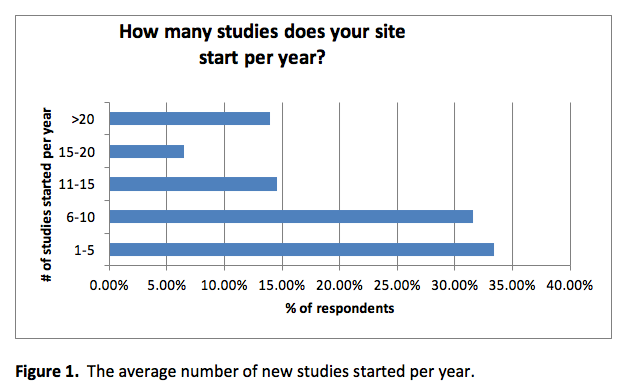
Of these trials, on average, less than 10% of the trials the sites contract with are rescue studies. This roughly translates to about one rescue trial that the survey respondents take on each year (Figure 2).
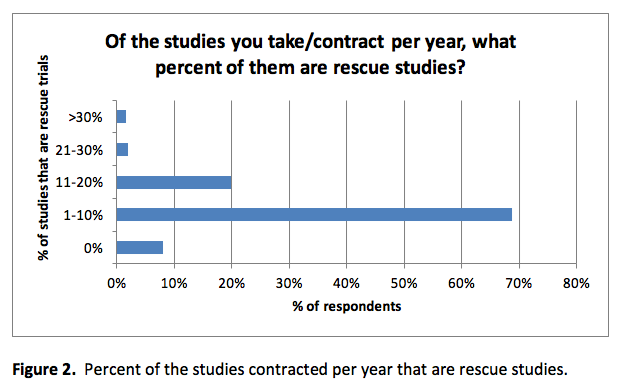
Interestingly, for the most part, when the sites are approached about a rescue opportunity, they typically sign on for the trial (Figure 3). This may reflect a general phenomenon for sites overall; they optimistically accept all trials regardless of whether issues about enrollment or other challenges are known upfront or not. The psychology of sites accepting protocols and sponsors/CROs accepting sites for which they are not well suited likely contributes to the chronic problem of rescue studies in the industry and warrants further exploration.

On the other hand, the survey results revealed that sites are not always made aware, up front, that a study is in rescue mode (Figure 4). Not being aware of the situation can certainly impact the site’s enrollment performance, so it behooves all parties to thoroughly assess the situation before making a commitment to participate.
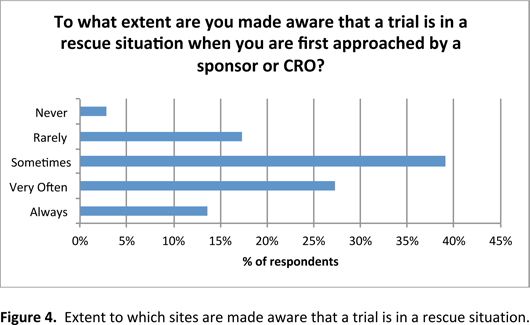
When sites are made aware that a study is in rescue, they report a myriad of variables that they assess before making the decision to accept the trial. The availability of the patient population and ability to successfully enroll was by far the primary factor sites considered when taking on a rescue project (Figure 5).
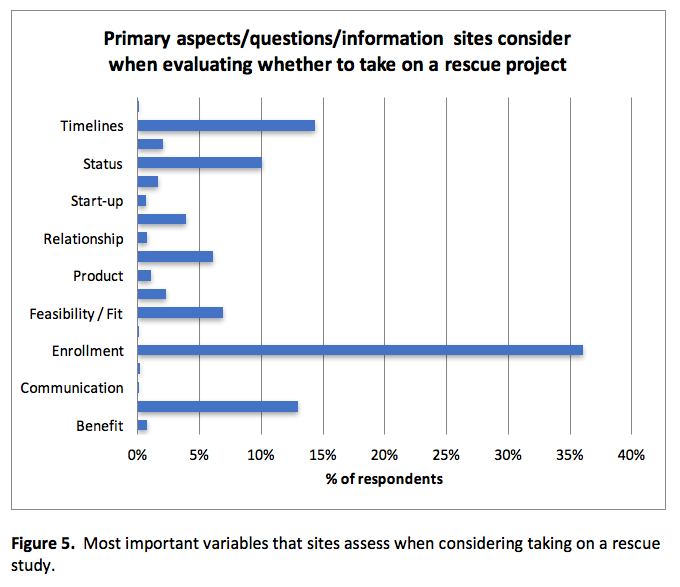
The majority of the survey respondents noted that they are only sometimes made aware of the specifics, with about 20% reporting that they are rarely or never made aware of the details (Figure 6). Whether this is an obligation of the sponsor to reveal this, or the site to demand this information, may be a matter of debate. Nonetheless, without a detailed understanding of the factors leading to poor enrollment, the add-on sites are at risk for performing the same or worse than the existing sites.
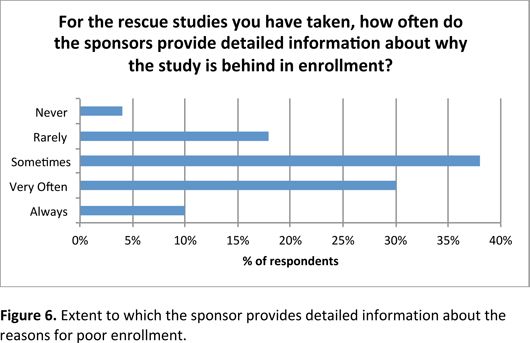
Regardless of how much information about the enrollment challenges is received or revealed, the survey respondents noted that they only receive additional support in about 25% of the cases. The majority of time the sites report receiving only the same level of support from the sponsor/CRO, as in a non-rescue situation (Figure 7). Sponsors and CROs may be missing a golden opportunity to set the add-on sites up for maximum enrollment success. Above and beyond this, it’s also critical to address the needs of the current sites who may need some support, without abandoning them altogether in favor of adding on additional sites.
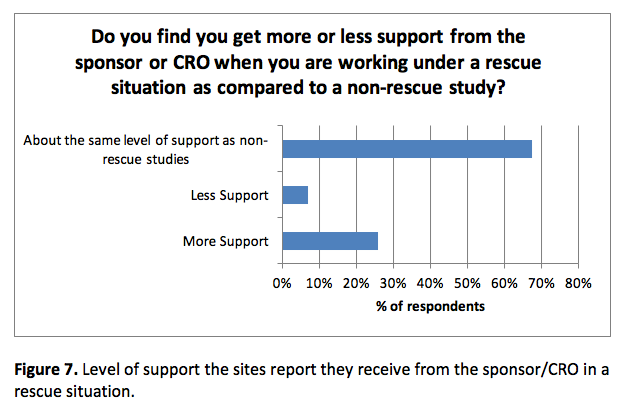
The vast majority of respondents indicate that their enrollment in these trials, sometimes exceeds enrollment in the non-rescue situation, with about 20% of the sites indicating their performance rarely or never exceeds that of the non-rescue situation (Figure 8). It should also be noted, however, that the target is frequently lowered for rescue sites, which makes it easier to achieve the enrollment goal. Furthermore, protocol amendments may make entry criteria a bit easier in many of the rescue situations as well.
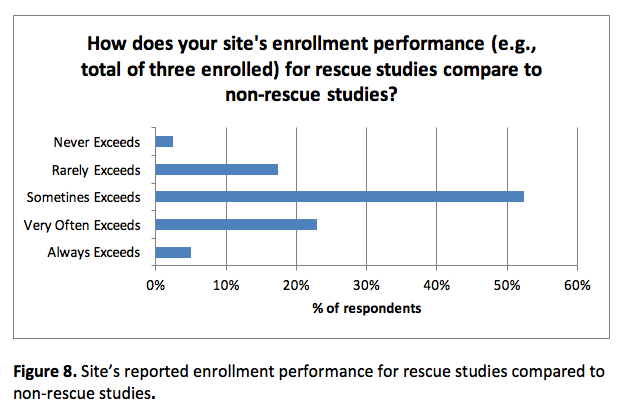
Whether additional support would have a significant impact on the site’s enrollment performance may be difficult to quantify; however, intuitively, it makes sense that helping the add-on sites would lead to even better performance. The same would apply to current sites. When asked about the type of support that would promote a more successful collaboration in rescue situations, sites reported a number of areas where they feel sponsors and CROs could be more helpful (Figure 9). Not surprisingly, being transparent about and addressing all of the root cause issues contributing to the rescue situation ranked highest in terms of ensuring success in these situations.

Make the most out of a rescue situation
Based on self-reported results, the majority of sites who take on rescue studies have some success in enrolling for them; however, they may be even more successful with some additional transparency and support. The right type and amount of support for current sites would also be beneficial. Most sites want to understand the challenges ahead of them through full disclosure about the successes, study issues, and timeline constraints. Sponsors and CROs could improve in these areas, as only 41% of the surveyed sites are always or very often made aware that a trial is in a rescue situation when first approached by a sponsor or CRO. Furthermore, sites report that sponsors provide detailed information about why the study is behind in enrollment very often or always only about 40% of the time.
With the pressure of finding patients in a shorter timeline in rescue studies, sponsors need to recognize that sites need and will benefit from more support, particularly in the area of recruitment support. With the majority of the sites (~70%) reporting they received about the same level or less support from the sponsor or CRO when working under a rescue situation as compared to a non-rescue study, this presents a major opportunity for improvement.
Adding more sites can be a solution, but the sunk cost with existing sites is significant. Since enrollment at sites tends to be serendipitous, it behooves sponsors to identify sites that have strong potential but just do not have the tools and time to focus on enhanced recruitment, especially for studies with stringent entry criteria where a wider but focused net must be cast. Examples of tactics for current sites, and new rescue sites, include:
- Gain access to site and site-related electronic medical records (EMRs) and databases to validate true enrollment potential and drive efficient patient prescreening.
- Gain access to HCPs that are in the care continuum for the desired population and ensure they have easy access to the study and patient transfer process.
- Ensure all central and local media leads have been reconciled and processed.
Sites share an equal responsibility for ensuring a successful collaboration in rescue situations. Some specific best practices and questions the sites should consider include the following:
- Compare the study’s challenges with your site’s experience in similar trials. Is your site going to be able to overcome what is a challenge for other sites?
- How will the site find the patient (e.g., databases, provider referrals, principal investigators practice patients as they present, media)?
- What are the studies top three prescreen disqualifiers and screen fail reasons? How does this impact your patient pool?
- If you aren’t able to recruit from your known patient population or a well-established referral base, how much and what type of recruitment support (e.g., budget, recruitment service provider) will be available to help you reach the target population?
- Have you taken studies like this in the past? Did you succeed in meeting your goal? If not, how will this study be different?
- From a budget and contractual standpoint, are there any obvious issues that will preclude you from a rapid start-up? Will the budget cover your start-up expenses and efforts in the event enrollment is met or the trial is terminated before you actually get initiated?
- Do you have the staff and resources to dedicate to the trial and are they willing and able to work within the additional pressure inherent in a rescue situation?
- Logistically, can you conduct the study visits and procedures with the space, time, and staff that you have?
- Are any of the inclusion/exclusion criteria ambiguous and/or subject to interpretation? If so, clarify your position with the sponsor to ensure alignment.
- Have protocol amendments occurred or will they occur? What’s the anticipated impact?
- If central or local media will be implemented, what type of support will be provided to ensure site burden is minimized.
Summary and conclusions
While rescue situations may be an inevitable fact of life for the clinical trials industry, the results of this survey highlight important and actionable insights that sponsors, CROs, and sites should consider when faced with enrollment challenges. It’s important not to assume all current sites can’t increase enrollment with the appropriate resources and support. At the same time, it might be time to close many current sites if indeed they have no additional potential to enroll. For add-on sites, being forthright about the fact a trial is in rescue, sharing as much information about the causative factors and what’s being done to address these can all have a significant impact on ultimately achieving the enrollment goals. The fact is that all study stakeholders share an important role in ensuring enrollment rescue success.
Pete Fronte is President/CEO of Altura; email: pfronte@alturastudies.com; Beth Harper is President of Clinical Performance Partners, Inc.; email: bharper@clinicalperformancepartners.com
References
1. Getz, K. Enrollment Performance: Weighing the "Facts." Applied Clinical Trials 2012. http://www.appliedclinicaltrialsonline.com/enrollment-performance-weighing-facts
2. Carlisle, B. et al. Unsuccessful trial accrual and human subject protections: an empirical analysis of recently closed trials. Clin Trials 2015. https://www.ncbi.nlm.nih.gov/pubmed/25475878
3. Source: Clinical Performance Partners, Inc. 2010
4. Source: GoBalto. Better Study Startup Means Less Rescue. https://www.gobalto.com/blog/better-study-startup-means-less-study-rescue
5. Source: CenterWatch-ACRP Career and Salary Survey 2015; N=2,508
Improving Relationships and Diversifying the Site Selection Process
April 17th 2025In this episode of the Applied Clinical Trials Podcast, Liz Beatty, co-founder and chief strategy officer, Inato, discusses a number of topics around site engagement including community-based sites, the role of technology in improving site/sponsor relationships, how increased operational costs are impacting the industry, and more.